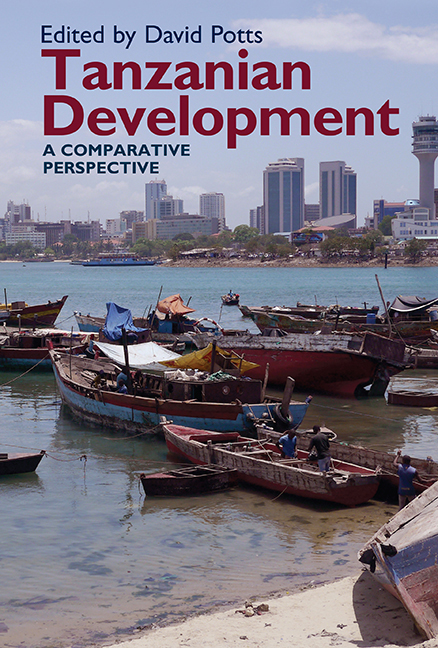Book contents
- Frontmatter
- Contents
- List of Illustrations
- Contributors
- Acknowledgements
- 1 Introduction – Tanzanian Development: A Comparative Perspective
- 2 The Political Economy of Tanzania 1967–2017: Reimagining the State
- 3 Reflections on the Tanzanian Trajectory: Decline and Recovery
- 4 Agricultural Development in Tanzania
- 5 Assets and Poverty Dynamics: The Methodological Challenges of Constructing Longitudinal Surveys in Tanzania
- 6 Contract Farming in Tanzania: Experiences from Tobacco and Sunflower
- 7 ‘We Just Sell Water – That is All We Do’: Two Cases of Small-scale Irrigation in Tanzania
- 8 The Industrial Development of Tanzania in Comparative African Perspective
- 9 Competitiveness in African Manufacturing: Some Evidence from Tanzania
- 10 ‘Good Life Never Comes Like Dreams’: Youth, Poverty and Employment in Arusha
- 11 International Aid to Tanzania – with some comparisons from Ghana and Uganda
- 12 Real Exchange Rate Changes and Export Performance in Tanzania and Ethiopia
- 13 Economic Leakage as a Constraint on Tourism's Effective Contribution to Local Economic Development in Tanzania
- 14 Extractive Industry Revenues and their Expenditure in Local Government Authorities: The Case of the Gold Service Levy in Geita District Council in Tanzania
- 15 Conclusion
- References
- Index
9 - Competitiveness in African Manufacturing: Some Evidence from Tanzania
Published online by Cambridge University Press: 24 October 2019
- Frontmatter
- Contents
- List of Illustrations
- Contributors
- Acknowledgements
- 1 Introduction – Tanzanian Development: A Comparative Perspective
- 2 The Political Economy of Tanzania 1967–2017: Reimagining the State
- 3 Reflections on the Tanzanian Trajectory: Decline and Recovery
- 4 Agricultural Development in Tanzania
- 5 Assets and Poverty Dynamics: The Methodological Challenges of Constructing Longitudinal Surveys in Tanzania
- 6 Contract Farming in Tanzania: Experiences from Tobacco and Sunflower
- 7 ‘We Just Sell Water – That is All We Do’: Two Cases of Small-scale Irrigation in Tanzania
- 8 The Industrial Development of Tanzania in Comparative African Perspective
- 9 Competitiveness in African Manufacturing: Some Evidence from Tanzania
- 10 ‘Good Life Never Comes Like Dreams’: Youth, Poverty and Employment in Arusha
- 11 International Aid to Tanzania – with some comparisons from Ghana and Uganda
- 12 Real Exchange Rate Changes and Export Performance in Tanzania and Ethiopia
- 13 Economic Leakage as a Constraint on Tourism's Effective Contribution to Local Economic Development in Tanzania
- 14 Extractive Industry Revenues and their Expenditure in Local Government Authorities: The Case of the Gold Service Levy in Geita District Council in Tanzania
- 15 Conclusion
- References
- Index
Summary
Introduction
There is a long tradition in economics that argues that manufacturing industry is critical for economic growth, particularly at relatively low income per capita (Weiss 2011). This ‘engine of growth argument’ rests on several features of the sector:
• Output per worker (productivity) is normally considerably higher than in agriculture or services (although not in mining) so that structural change in favour of manufacturing raises the overall productivity of an economy.
• Productivity growth in manufacturing has historically been more rapid than in other sectors owing to greater technical change and learning effects.
• Manufacturing is the sector where there is greater scope for specialization as outputs grows.
• Its linkages with other parts of the economy are greater than for any other aggregate sector.
• As a key tradable sector, manufacturing expansion allows access to the world market and faces better demand prospects there than primary exports.
The normal historical pattern has been that, in poor countries, the share of manufacturing in total economic activity is very low, but that as growth occurs and workers move out of agriculture, it rises rapidly. Once a threshold income level is passed the relative share of manufacturing starts to decline as demand shifts towards services. Thus for example, in 2005, manufacturing was 9 per cent of GDP in Ghana, 30 per cent of GDP in a middle- income economy like Malaysia and averaged 16 per cent in the OECD economies (Smirzai 2013: Table 1.2). It is at the transition from low to middle income status that the engine of growth effect can be expected to be greatest owing to the greater scope for a productivity boost as workers shift out of agriculture.
Experience in sub-Saharan Africa has not matched this positive story. The sector remains relatively small with much of it vulnerable to competition from imports. This chapter discusses evidence on recent Tanzanian experience in the context of industrialization in Africa more generally, drawing in some instances on empirical work by the authors. It considers industrialization in Tanzania from the perspective of economic competitiveness, and therefore should be seen as complementary to the broader discussion of the political economy of industrial development in Tanzania given in Chapter 8. We look at African experience, before turning to the Tanzanian case, and then present some empirical evidence from firm-level surveys of manufacturers in Tanzania before concluding the chapter.
- Type
- Chapter
- Information
- Tanzanian DevelopmentA Comparative Perspective, pp. 182 - 198Publisher: Boydell & BrewerPrint publication year: 2019

